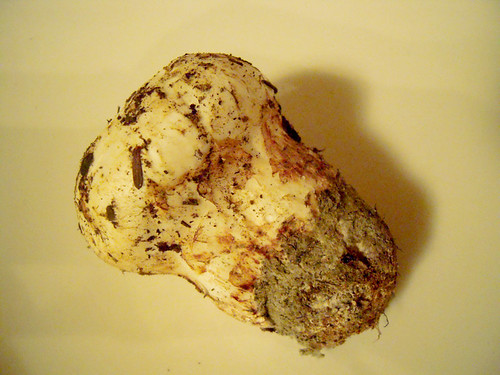 Matsutake
Matsutake are to Japan as
truffles are to France. They are hard-to-find, fragrant, expensive and coveted. "Matsu" means pine and "take" means mushroom.
Matsutake are harvested in the fall, the earliest occurring in September from pine forests in diverse locations around the world including Korea, China, British Columbia, Morocco, Sweden, California and Japan.
The matsutake I have access to in California are foraged in forests from Oregon and California. Keeping it local adds to the freshness factor, but sadly these do not hold up to the super fragrant matsutake that grow in Korea and Japan. This is due to the fact that pine types differ in Asia and North America. The matsutake which grow in Japan and other parts of Asia stem from Japanese Red Pine while in North America, the matsutake spawn at the base of various fir and pine trees (including Douglas and Noble firs, and Sugar and Ponderosa Pines). Different trees yield different types of matsutake.
In the hierarchy of the matsutake world, the North American mushrooms are referred to as White Matsutake, as opposed to matsutake that are harvested in Asia which are more brown in color and more fragrant. As a result, White Matsutake are considered the lesser matsutake.
It's the tail-end of matsutake season here in North America and the third time I've purchased matsutake at my local grocery store this season. Matsutake are currently priced at a mind-boggling bargain of $18/lb. Considering that in Japan matsutake can easily cost $100/lb, I feel like a thief.
How to Choose Matsutake
Matsutake are sorted by grades One to Six. Although it's hard to believe that bigger is not better, you better believe it with matsutake. Let's make it easy and say, "the younger, the better."
Grade One matsutake are the creme de la creme. Again, let's make it easy and say "the ones that look like penises." The cap is still unbroken, so it doesn't look like a mushroom in a conventional sense-- with the usual stalk and cap. Grade One matsutake are the most tender and will stay fresher longer than the the other grades.
As you progress to grade Six, they look more like portabello mushrooms-- wide caps and veins on the underside of the caps are prominent.
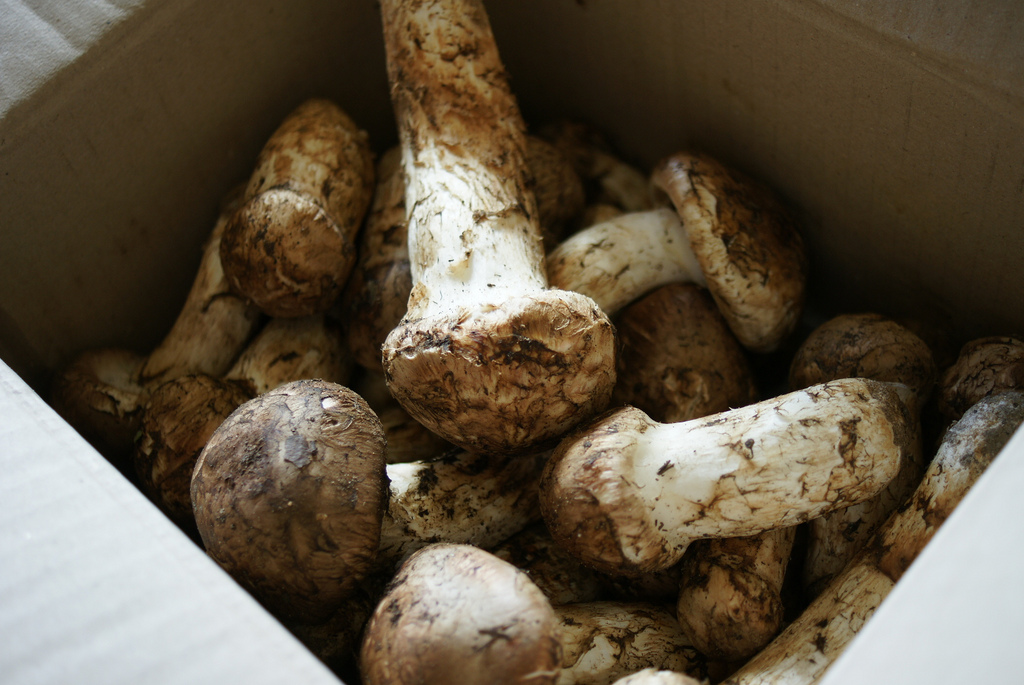 Flickr user: rok1966
Flickr user: rok1966
In the above photo, the two well-lit ones in focus are ideal, as opposed to the older mushrooms under it with wide caps.
If you can't seem to find a grade One-ish matsutake try to get ones with the least cap-to-stem ratio (no distinct cap). Here's what I chose.
 Preparation
Preparation
Make sure to clean off any excess dirt on the matsutake before preparation. This can be done with a brush or by peeling a thin layer off of them.
The easiest way to enjoy matsutake is to lightly (keyword "lightly") saute thinly sliced matsutake in butter. There's no fuss and it will make you feel like royalty. Umami explosion.
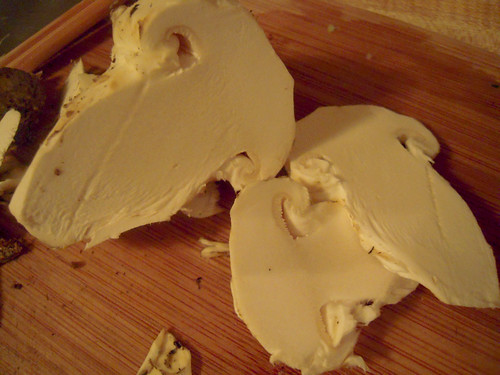
But the BEST way to prepare matsutake is in broth which showcases its aroma and umami.
Last night, I added the matsutake to make a dashi stock for a warm
nabe dinner. I sliced the matsutake thin and put them into a hot pot (donabe) full of
kombu dashi.
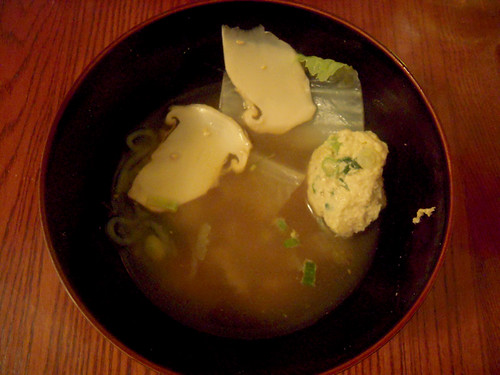
It was a night of endless pleasure. Which led me to recall a few lines from one of Celine Dion's songs.
There were nights of endless pleasure
It was more than all your laws allow
Which kind of made me want to barf a little.
So let's put Celine Dion to the side-- way off to the side.
Taking center stage on my plate tonight is matsutake. Its earthy, meaty aroma captivates any audience. Still unknown to many people in the west, matsutake is in the green room, ready to be a superstar.
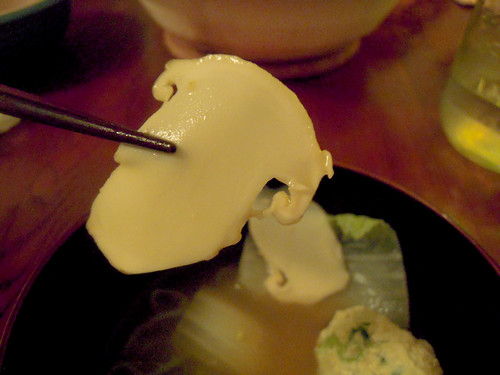
 Matsutake are to Japan as truffles are to France. They are hard-to-find, fragrant, expensive and coveted. "Matsu" means pine and "take" means mushroom.
Matsutake are harvested in the fall, the earliest occurring in September from pine forests in diverse locations around the world including Korea, China, British Columbia, Morocco, Sweden, California and Japan.
The matsutake I have access to in California are foraged in forests from Oregon and California. Keeping it local adds to the freshness factor, but sadly these do not hold up to the super fragrant matsutake that grow in Korea and Japan. This is due to the fact that pine types differ in Asia and North America. The matsutake which grow in Japan and other parts of Asia stem from Japanese Red Pine while in North America, the matsutake spawn at the base of various fir and pine trees (including Douglas and Noble firs, and Sugar and Ponderosa Pines). Different trees yield different types of matsutake.
In the hierarchy of the matsutake world, the North American mushrooms are referred to as White Matsutake, as opposed to matsutake that are harvested in Asia which are more brown in color and more fragrant. As a result, White Matsutake are considered the lesser matsutake.
It's the tail-end of matsutake season here in North America and the third time I've purchased matsutake at my local grocery store this season. Matsutake are currently priced at a mind-boggling bargain of $18/lb. Considering that in Japan matsutake can easily cost $100/lb, I feel like a thief.
How to Choose Matsutake
Matsutake are sorted by grades One to Six. Although it's hard to believe that bigger is not better, you better believe it with matsutake. Let's make it easy and say, "the younger, the better."
Grade One matsutake are the creme de la creme. Again, let's make it easy and say "the ones that look like penises." The cap is still unbroken, so it doesn't look like a mushroom in a conventional sense-- with the usual stalk and cap. Grade One matsutake are the most tender and will stay fresher longer than the the other grades.
As you progress to grade Six, they look more like portabello mushrooms-- wide caps and veins on the underside of the caps are prominent.
Matsutake are to Japan as truffles are to France. They are hard-to-find, fragrant, expensive and coveted. "Matsu" means pine and "take" means mushroom.
Matsutake are harvested in the fall, the earliest occurring in September from pine forests in diverse locations around the world including Korea, China, British Columbia, Morocco, Sweden, California and Japan.
The matsutake I have access to in California are foraged in forests from Oregon and California. Keeping it local adds to the freshness factor, but sadly these do not hold up to the super fragrant matsutake that grow in Korea and Japan. This is due to the fact that pine types differ in Asia and North America. The matsutake which grow in Japan and other parts of Asia stem from Japanese Red Pine while in North America, the matsutake spawn at the base of various fir and pine trees (including Douglas and Noble firs, and Sugar and Ponderosa Pines). Different trees yield different types of matsutake.
In the hierarchy of the matsutake world, the North American mushrooms are referred to as White Matsutake, as opposed to matsutake that are harvested in Asia which are more brown in color and more fragrant. As a result, White Matsutake are considered the lesser matsutake.
It's the tail-end of matsutake season here in North America and the third time I've purchased matsutake at my local grocery store this season. Matsutake are currently priced at a mind-boggling bargain of $18/lb. Considering that in Japan matsutake can easily cost $100/lb, I feel like a thief.
How to Choose Matsutake
Matsutake are sorted by grades One to Six. Although it's hard to believe that bigger is not better, you better believe it with matsutake. Let's make it easy and say, "the younger, the better."
Grade One matsutake are the creme de la creme. Again, let's make it easy and say "the ones that look like penises." The cap is still unbroken, so it doesn't look like a mushroom in a conventional sense-- with the usual stalk and cap. Grade One matsutake are the most tender and will stay fresher longer than the the other grades.
As you progress to grade Six, they look more like portabello mushrooms-- wide caps and veins on the underside of the caps are prominent.
 Flickr user: rok1966
In the above photo, the two well-lit ones in focus are ideal, as opposed to the older mushrooms under it with wide caps.
If you can't seem to find a grade One-ish matsutake try to get ones with the least cap-to-stem ratio (no distinct cap). Here's what I chose.
Flickr user: rok1966
In the above photo, the two well-lit ones in focus are ideal, as opposed to the older mushrooms under it with wide caps.
If you can't seem to find a grade One-ish matsutake try to get ones with the least cap-to-stem ratio (no distinct cap). Here's what I chose.
 Preparation
Make sure to clean off any excess dirt on the matsutake before preparation. This can be done with a brush or by peeling a thin layer off of them.
The easiest way to enjoy matsutake is to lightly (keyword "lightly") saute thinly sliced matsutake in butter. There's no fuss and it will make you feel like royalty. Umami explosion.
Preparation
Make sure to clean off any excess dirt on the matsutake before preparation. This can be done with a brush or by peeling a thin layer off of them.
The easiest way to enjoy matsutake is to lightly (keyword "lightly") saute thinly sliced matsutake in butter. There's no fuss and it will make you feel like royalty. Umami explosion.
 But the BEST way to prepare matsutake is in broth which showcases its aroma and umami.
Last night, I added the matsutake to make a dashi stock for a warm nabe dinner. I sliced the matsutake thin and put them into a hot pot (donabe) full of kombu dashi.
But the BEST way to prepare matsutake is in broth which showcases its aroma and umami.
Last night, I added the matsutake to make a dashi stock for a warm nabe dinner. I sliced the matsutake thin and put them into a hot pot (donabe) full of kombu dashi.
 It was a night of endless pleasure. Which led me to recall a few lines from one of Celine Dion's songs.
There were nights of endless pleasure
It was more than all your laws allow
Which kind of made me want to barf a little.
So let's put Celine Dion to the side-- way off to the side.
Taking center stage on my plate tonight is matsutake. Its earthy, meaty aroma captivates any audience. Still unknown to many people in the west, matsutake is in the green room, ready to be a superstar.
It was a night of endless pleasure. Which led me to recall a few lines from one of Celine Dion's songs.
There were nights of endless pleasure
It was more than all your laws allow
Which kind of made me want to barf a little.
So let's put Celine Dion to the side-- way off to the side.
Taking center stage on my plate tonight is matsutake. Its earthy, meaty aroma captivates any audience. Still unknown to many people in the west, matsutake is in the green room, ready to be a superstar.





Comments (2)
mmm butter and truffles. this sounds amazing. I’m starving now.
Great post!
Want to buy White Matsutake from Canada call James Wesley here at 250-842-7027 lots here for sale